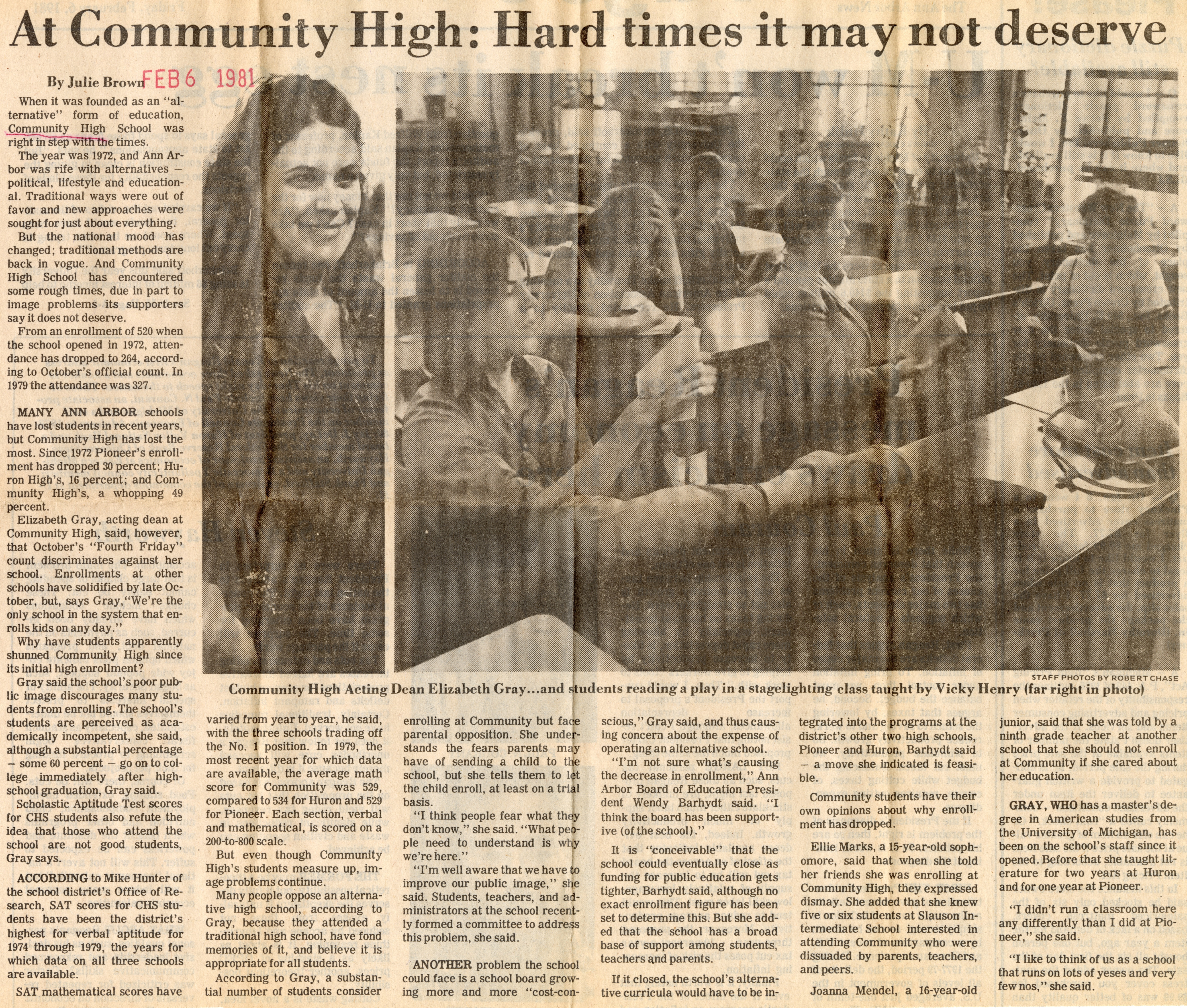At Community High: Hard Times It May Not Deserve

At Community High: Hard times it may not deserve
By Julie Brown
FEB 6 1981
STAFF PHOTO BY ROBERT CHASE
Community High Acting Dean Elizabeth Gray and students reading a play in a stagelighting class taught by Vicky Henry (far right in photo)
When it was founded as an "alternative” form of education, Community High School was right in step with the times.
The year was 1972, and Ann Arbor was rife with alternatives — political, lifestyle and educational. Traditional ways were out of favor and new approaches were sought for just about everything.
But the national mood has changed; traditional methods are back in vogue. And Community High School has encountered some rough times, due in part to image problems its supporters say it does not deserve.
From an enrollment of 520 when the school opened in 1972, attendance has dropped to 264, according to October’s official count. In 1979 the attendance was 327.
MANY ANN ARBOR schools have lost students in recent years, but Community High has lost the most. Since 1972 Pioneer’s enrollment has dropped 30 percent; Huron High’s, 16 percent; and Community High’s, a whopping 49 percent.
Elizabeth Gray, acting dean at Community High, said, however, that October’s “Fourth Friday” count discriminates against her school. Enrollments at other schools have solidified by late October, but, says Gray,“We’re the only school in the system that enrolls kids on any day."
Why have students apparently shunned Community High since its initial high enrollment?
Gray said the school’s poor public image discourages many students from enrolling. The school’s students are perceived as academically incompetent, she said, although a substantial percentage - some 60 percent - go on to college immediately after high-school graduation, Gray said.
Scholastic Aptitude Test scores for CHS students also refute the idea that those who attend the school are not good students, Gray says.
ACCORDING to Mike Hunter of the school district’s Office of Research, SAT scores for CHS students have been the district’s highest for verbal aptitude for 1974 through 1979, the years for which data on all three schools are available.
SAT mathematical scores have varied from year to year, he said, with the three schools trading off the No. 1 position. In 1979, the most recent year for which data are available, the average math score for Community was 529, compared to 534 for Huron and 529 for Pioneer. Each section, verbal and mathematical, is scored on a 200-to-800 scale.
But even though Community High’s students measure up, image problems continue.
Many people oppose an alternative high school, according to Gray, because they attended a traditional high school, have fond memories of it, and believe it is appropriate for all students.
According to Gray, a substantial number of students consider enrolling at Community but face parental opposition. She understands the fears parents ma(y have of sending a child to the school, but she tells them to let the child enroll, at least on a trial basis.
“I think people fear what they don’t know,” she said. “What people need to understand is why we’re here.”
“I’m well aware that we have to improve our public image,” she said. Students, teachers, and administrators at the school recently formed a committee to address this problem, she said.
ANOTHER problem the school could face is a school board growing more and more “cost-conscious,” Gray said, and thus causing concern about the expense of operating an alternative school.
“I’m not sure what’s causing the decrease in enrollment,” Ann Arbor Board of Education President Wendy Barhydt said. “I think the board has been supportive (of the school).”
It is “conceivable” that the school could eventually close as funding for public education gets tighter, Barhydt said, although no exact enrollment figure has been set to determine this. But she added that the school has a broad base of support among students, teachers and parents.
If it closed, the school’s alternative curricula would have to be integrated into the programs at the district’s other two high schools, Pioneer and Huron, Barhydt said - a move she indicated is feasible.
Community students have their own opinions about why enrollment has dropped.
Ellie Marks, a 15-year-old sophomore, said that when she told her friends she was enrolling at Community High, they expressed dismay. She added that she knew five or six students at Slauson Intermediate School interested in attending Community who were dissuaded by parents, teachers, and peers.
Joanna Mendel, a 16-year-old junior, said that she was told by a ninth grade teacher at another school that she should not enroll at Community if she cared about her education.
GRAY, WHO has a master’s degree in American studies from the University of Michigan, has been on the school’s staff since it opened. Before that she taught literature for two years at Huron and for one year at Pioneer.
“I didn’t run a classroom here any differently than I did at Pioneer,” she said.
“I like to think of us as a school that runs on lots of yeses and very few nos,’’she said.